The tandem CCCH zinc finger protein tristetraprolin and its relevance to cytokine mRNA turnover and arthritis
- PMID: 15535838
- PMCID: PMC1064869
- DOI: 10.1186/ar1441
The tandem CCCH zinc finger protein tristetraprolin and its relevance to cytokine mRNA turnover and arthritis
Abstract
Tristetraprolin (TTP) is the best-studied member of a small family of three proteins in humans that is characterized by a tandem CCCH zinc finger (TZF) domain with highly conserved sequences and spacing. Although initially discovered as a gene that could be induced rapidly and transiently by the stimulation of fibroblasts with growth factors and mitogens, it is now known that TTP can bind to AU-rich elements in mRNA, leading to the removal of the poly(A) tail from that mRNA and increased rates of mRNA turnover. This activity was discovered after TTP-deficient mice were created and found to have a systemic inflammatory syndrome with severe polyarticular arthritis and autoimmunity, as well as medullary and extramedullary myeloid hyperplasia. The syndrome seemed to be due predominantly to excess circulating tumor necrosis factor-alpha (TNF-alpha), resulting from the increased stability of the TNF-alpha mRNA and subsequent higher rates of secretion of the cytokine. The myeloid hyperplasia might be due in part to increased stability of granulocyte-macrophage colony-stimulating factor (GM-CSF). This review highlights briefly the characteristics of the TTP-deficiency syndrome in mice and its possible genetic modifiers, as well as recent data on the characteristics of the TTP-binding site in the TNF-alpha and GM-CSF mRNAs. Recent structural data on the characteristics of the complex between RNA and one of the TTP-related proteins are reviewed, and used to model the TTP-RNA binding complex. We review the current knowledge of TTP sequence variants in humans and discuss the possible contributions of the TTP-related proteins in mouse physiology and in human monocytes. The TTP pathway of TNF-alpha and GM-CSF mRNA degradation is a possible novel target for anti-TNF-alpha therapies for rheumatoid arthritis, and also for other conditions proven to respond to anti-TNF-alpha therapy.
Figures
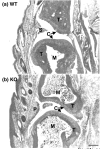

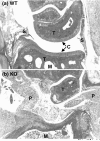



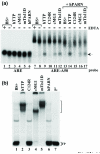
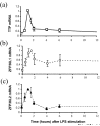
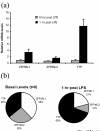
Similar articles
-
Gene transduction of tristetraprolin or its active domain reduces TNF-alpha production by Jurkat T cells.Int J Mol Med. 2006 May;17(5):801-9. Int J Mol Med. 2006. PMID: 16596264
-
Zfp36l3, a rodent X chromosome gene encoding a placenta-specific member of the Tristetraprolin family of CCCH tandem zinc finger proteins.Biol Reprod. 2005 Aug;73(2):297-307. doi: 10.1095/biolreprod.105.040527. Epub 2005 Apr 6. Biol Reprod. 2005. PMID: 15814898
-
Similar but distinct effects of the tristetraprolin/TIS11 immediate-early proteins on cell survival.Oncogene. 2000 Mar 23;19(13):1657-64. doi: 10.1038/sj.onc.1203474. Oncogene. 2000. PMID: 10763822
-
Post-transcriptional regulation of proinflammatory proteins.J Leukoc Biol. 2004 Jul;76(1):42-7. doi: 10.1189/jlb.1103536. Epub 2004 Apr 1. J Leukoc Biol. 2004. PMID: 15075353 Review.
-
Tristetraprolin and other CCCH tandem zinc-finger proteins in the regulation of mRNA turnover.Biochem Soc Trans. 2002 Nov;30(Pt 6):945-52. doi: 10.1042/bst0300945. Biochem Soc Trans. 2002. PMID: 12440952 Review.
Cited by
-
Tristetraprolin as a Therapeutic Target in Inflammatory Disease.Trends Pharmacol Sci. 2016 Oct;37(10):811-821. doi: 10.1016/j.tips.2016.07.002. Epub 2016 Aug 5. Trends Pharmacol Sci. 2016. PMID: 27503556 Free PMC article. Review.
-
Crosstalk in inflammation: the interplay of glucocorticoid receptor-based mechanisms and kinases and phosphatases.Endocr Rev. 2009 Dec;30(7):830-82. doi: 10.1210/er.2009-0013. Epub 2009 Nov 4. Endocr Rev. 2009. PMID: 19890091 Free PMC article. Review.
-
Molecular mechanisms of the anti-inflammatory functions of interferons.Immunobiology. 2007;212(9-10):895-901. doi: 10.1016/j.imbio.2007.09.011. Epub 2007 Nov 8. Immunobiology. 2007. PMID: 18086388 Free PMC article. Review.
-
Putative molecular mechanisms underlying tandem CCCH zinc finger protein mediated plant growth, stress, and gene expression responses.Plant Signal Behav. 2011 May;6(5):647-51. doi: 10.4161/psb.6.5.15105. Plant Signal Behav. 2011. PMID: 21795857 Free PMC article. Review.
-
Role of the RNA-binding protein tristetraprolin in glucocorticoid-mediated gene regulation.J Immunol. 2008 Jun 15;180(12):8342-53. doi: 10.4049/jimmunol.180.12.8342. J Immunol. 2008. PMID: 18523301 Free PMC article.
References
-
- Lai WS, Stumpo DJ, Blackshear PJ. Rapid insulin-stimulated accumulation of an mRNA encoding a proline-rich protein. J Biol Chem. 1990;265:16556–16563. - PubMed
-
- Ma Q, Herschman HR. A corrected sequence for the predicted protein from the mitogen-inducible TIS11 primary response gene. Oncogene. 1991;6:1277–1278. - PubMed
-
- Varnum BC, Lim RW, Sukhatme VP, Herschman HR. Nucleotide sequence of a cDNA encoding TIS11, a message induced in Swiss 3T3 cells by the tumor promoter tetradecanoyl phorbol acetate. Oncogene. 1989;4:119–120. - PubMed
-
- DuBois RN, McLane MW, Ryder K, Lau LF, Nathans D. A growth factor-inducible nuclear protein with a novel cysteine/histidine repetitive sequence. J Biol Chem. 1990;265:19185–19191. - PubMed
Publication types
MeSH terms
Substances
LinkOut - more resources
Full Text Sources
Molecular Biology Databases

